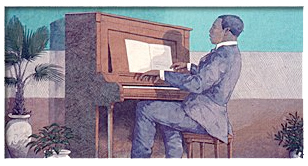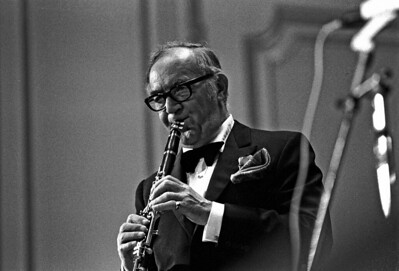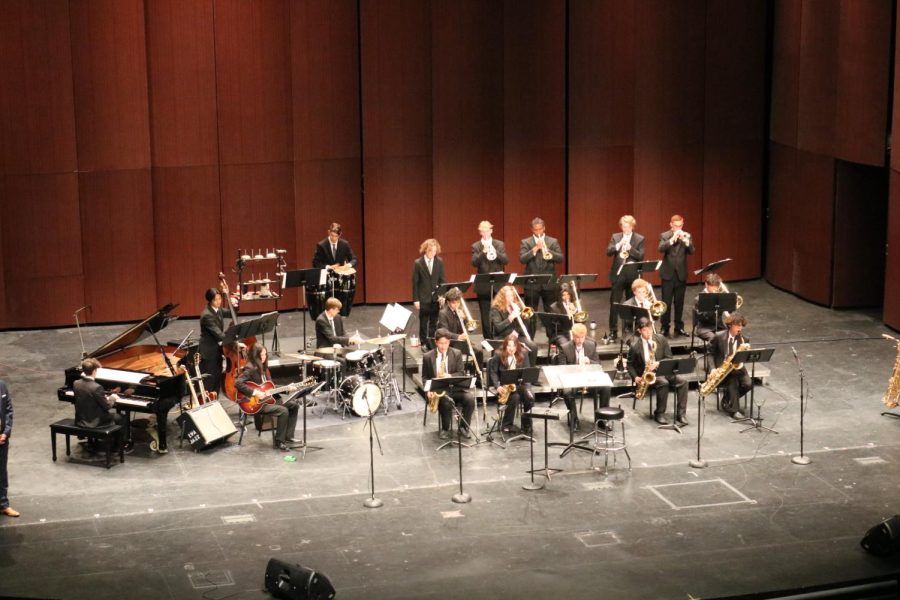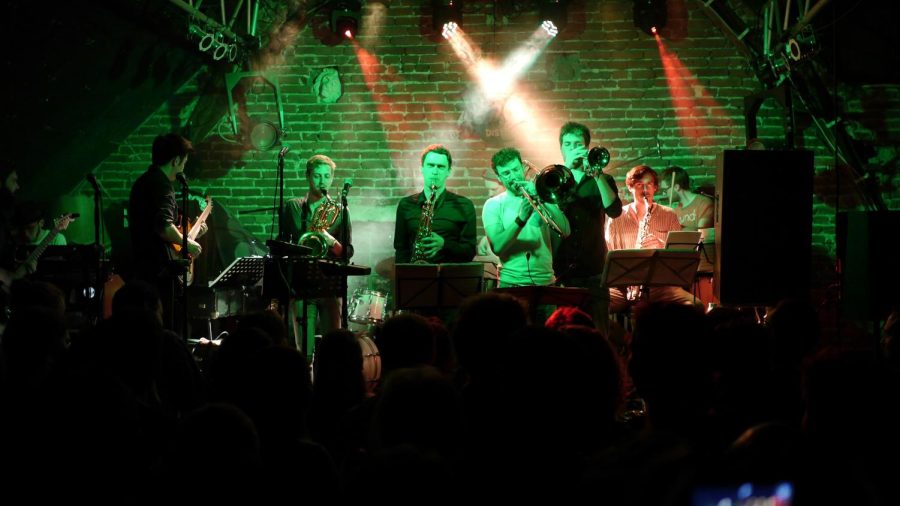Your donation will support the student journalists of Las Vegas Academy of the Arts. Your contribution will allow us retain our independence as journalists and to purchase equipment, attend journalism conferences, and cover our annual website hosting costs.

“Ragtime music, Scott Joplin and Sedalia, Missouri” by judy_breck is licensed under CC BY-SA 2.0.
Ragtime was one of the early forms of jazz that became widely popular.
Jazz: A Blog
November 29, 2022
Reporter Daemon Bawa researches and reflects upon jazz’s history and influence.
Early Jazz and the Jazz Age
In the first decade of the 20th century, jazz had begun to take hold as the next music craze in America. Artists such as Jelly Roll Morton, “The Original Creole Orchestra”, and “The Original Dixieland Jazz Band” touring the country with immense success. One marker of this new era was the first jazz recording, “Livery Stable Blues”, by “The Original Dixieland Jazz Band” in 1917. This was an all-white band; the first African American jazz recording was by Kid Ory’s band in 1922. These recordings and the successful tours brought jazz to new audiences, and the whole country loved it. In fact, groups were bringing ragtime to Europe as early as 1918, and as jazz developed in America, that would also arrive in Europe with the same positive reception. With the huge popularity of Kid Ory’s recording, by 1923 African American jazz bands and artists finally had the opportunity to record, which may have been denied to them previously due to racial discrimination.
Multiple historical and cultural events in the 1920’s had huge impacts on jazz music, namely Prohibition (the 18th Amendment, making the sale of alcohol illegal) and the cultural changes in the “Roaring 20’s”. The rebellious nature of younger generations in the 1920’s gave jazz a huge boost in popularity, simply due to the fact that middle-upper class white people tended to see it as improper. As successful as the music became, there were always people denying its value or status as “real music”. In addition, Prohibition led to the creation of speakeasies, or private, hidden alternatives to bars. As bars/saloons were forced to close, speakeasies replaced them, but they had to operate differently: they were smaller, but more numerous; they were no longer segregated; and jazz bands were a very popular choice for speakeasy entertainment. These factors gave jazz room to grow, but the new developments in the music itself were the most important part.
Early in the decade, Louis Armstrong and Fletcher Henderson began to make a name for themselves. In 1922, Louis Armstrong left New Orleans to join his mentor, King Oliver, and his band in Chicago. Armstrong was a master of the New Orleans style, but he also began to spearhead a new style of jazz, featuring soloists. In 1923, Fletcher Henderson formed the “Fletcher Henderson Orchestra”, which some see as the first proper jazz big band. Originally a dance band, over time the group developed more towards what we now see as big band jazz. Coincidentally, in 1924, Louis Armstrong joined the “Fletcher Henderson Orchestra” as featured soloist, marking a turning point in Armstrong’s development of the “soloist’s art” and Henderson’s development of big band jazz. In 1925, Armstrong made his first recordings with his group, “The Hot Five”, where he would later popularize scat singing. In 1924, Duke Ellington made his first recordings with “The Washingtonians”, and then in 1927 began a residency at the Cotton Club, foreshadowing his immense influence in the coming decade.
From the late 1920’s to the late 1930’s, big band swing took over as the dominant music of the time. Groups like Henderson’s, Ellington’s, Count Basie’s, and Benny Goodman’s gained immense popularity and influence. In 1932, Ellington’s orchestra recorded “It Don’t Mean a Thing, If it Ain’t Got That Swing”, the first known composition to use “swing” in the title. Also in 1932, Benny Goodman began playing with Henderson’s band. In 1934, facing financial difficulties, Henderson sold his arrangements to Goodman, who began to perform with his band with even more success. Henderson remained as Goodman’s arranger, and this band became one of the most important of the time, like Henderson’s had been in the last decade. Ellington also developed a unique style of orchestral jazz during this time, incorporating complex arrangements and different instrumentation and harmony than many other groups of the time. Despite this, he was one of the most popular bandleaders of the decade.
Another notable development of the 30’s was a relaxation of racial segregation in music. White bandleaders began to hire black musicians, and vice versa. It was very common in big bands and smaller jazz groups, which were also developing a new and interesting style. For example, Basie formed the “Barons of Rhythm”, featuring the jam session style of music and bringing it to new audiences. Benny Goodman began a racially integrated trio with Teddy Wilson and Gene Krupa. In France, guitarist Django Reinhardt and violinist Stephane Grappelli had their first public performance with the Quintette du Hot Club du France, an important development in European jazz. In 1936, Nat King Cole made his first recordings with the “Solid Swingers”, and the next year would form a group with piano, bass, and guitar.
In 1938, Benny Goodman’s band performed to a sold-out crowd at Carnegie Hall. The performance also included a jam session with musicians from Ellington’s and Basie’s bands. Afterwards, the Basie band had a competition with Chick Webb’s band at the Savoy Ballroom. This may be seen as a peak of the swing era, but the success would not last for long, with the beginning of World War II forcing a shift in every aspect of culture worldwide.
To read more about jazz and its history, keep an eye out for the next article, and check out the rest of the blog.
Sources:
Benny Goodman. (2023 January 27). Encyclopædia Britannica. Retrieved February 6, 2023, from https://www.britannica.com/biography/Benny-Goodman
Count Basie. (2023 January 17). Encyclopædia Britannica. Retrieved February 6, 2023, from https://www.britannica.com/biography/Count-Basie
Duke Ellington. (2023 January 16). Encyclopædia Britannica. Retrieved February 6, 2023, from https://www.britannica.com/biography/Duke-Ellington
Fletcher Henderson. (2022 December 25). Encyclopædia Britannica. Retrieved February 6, 2023, from https://www.britannica.com/biography/Fletcher-Henderson
Herbie Hancock Institute of Jazz. (n.d.). Jazz in America: Timeline. Jazz in America. Retrieved February 6, 2023, from https://www.jazzinamerica.org/JazzResources/Timeline/1920/1929
The Jazz Age in America. (n.d.). 1920s Fashion & Music. Retrieved February 6, 2023, from https://www.1920s-fashion-and-music.com/jazz-age.html
The Mob Museum. (n.d.). The Speakeasies of the 1920s. Prohibition. Retrieved February 6, 2023, from https://prohibition.themobmuseum.org/the-history/the-prohibition-underworld/the-speakeasies-of-the-1920s/
QHCF. Gypsy Jazz UK. (2015 March 11). Retrieved February 6, 2023, from https://gypsyjazzuk.wordpress.com/gypsy-jazz-uk-home/djangos-birth-and-early-childhood/quintette-du-hot-club-de-france/
Stewart, J. (n.d.). Jazz origins in New Orleans. National Parks Service. Retrieved February 6, 2023, from https://www.nps.gov/jazz/learn/historyculture/history_early.htm
Thomas, B. (n.d.). The Origins of Big Band Music – A History of Big Band Jazz. The origins of Big Band Music. Retrieved February 6, 2023, from https://web.archive.org/web/20081228133259/http://www.redhotjazz.com/bigband.html
The Influence of Jazz on Modern Music
Photo Credit: “P1750225 Sebastian Mueller Band @ Red Horn District” by tottr is licensed under CC BY-SA 2.0. To view a copy of this license, visit https://creativecommons.org/licenses/by-sa/2.0/?ref=openverse.
Jazz has severely decreased in popularity since the mid-1900’s, and many people today don’t even try to listen to it. However, many other kinds of music that those same people might enjoy have some kind of heavy influence from jazz. In fact, the vast majority of music from the early-1900’s or later has been influenced or even made possible directly by jazz music, whether the creators knew it or not. Speaking of which, it might surprise a lot of people to know that their favorite artists of their preferred genre might be fans of jazz themselves, and intentionally draw inspiration from it for their own music. All of this can be attributed to its cultural impacts, diversity, and history, along with the actual musical elements of the genre.
The history of jazz is difficult to summarize because there are so many hugely important events over such a long period of time, but it’s still possible. So, the origins of jazz are based in a mix of African/Afro-Cuban traditional music, European classical music, and early American styles (many of which were also made up of the same influences). These elements mixed very strongly in New Orleans, the birthplace of jazz, leading to music such as ragtime, arguably a precursor or the earliest form of jazz. After taking influence from blues music, jazz began to shape itself more and more into its own unique genre, with styles like Dixieland and early swing developing in the first few decades of the 1900’s. Swing quickly grew in popularity, and by the 1930’s had become the main pop music of the time. During and after World War II, jazz went through a major evolution, quickly splintering into many different styles. This marks a transition from pop music to “musician’s music”, a more complicated, intense style with many variations. Styles such as bebop, hard bop, cool jazz, and many more grew in popularity, as swing became outdated. By the 1960s, more complicated styles of jazz began to emerge, but there was also a revival of traditional jazz, which tended to be more audience friendly. Most importantly to this article, this was essentially when jazz began mixing with other genres like rock and funk, creating the fusion genre. Over the next decades, countless jazz and fusion genres were created, and today it can be hard to define the boundaries between many of these genres.
The history of jazz is so complicated because of its diversity, which is also a large factor in its influence in other music. Two people can say they like jazz music, and then find they don’t like any of the same artists. Over the last 100+ years, jazz has taken so many forms that there’s bound to be something there that most people will like, and especially something there that can inspire someone when writing their own music. Jazz harmony, rhythms, techniques, and mindsets have taken root in most styles of music today, and it’s very easy to trace most modern music back to jazz. For example, hip hop has an extensive record of sampling from jazz artists such as Miles Davis and Herbie Hancock (i.e. Cantaloop (Flip Fantasia) by Us3). Many classic rock bands cite jazz as their biggest influences, such as Led Zeppelin and Pink Floyd. Many early funk artists were previously known for jazz music (also including Miles Davis and Herbie Hancock), and many modern pop bands are made up mostly or entirely of jazz musicians, such as Justin Timberlake’s live band. This list could go on and on, covering almost all modern music, but the point is that if the music you like is so heavily influenced by jazz, maybe it’s worth looking a bit deeper into jazz.
If you’re interested in the history aspect or more examples of notable jazz pieces, there will be a multiple part article on jazz history uploaded on the Accolades website in the future.
Works Cited
“Jazz in America Resource Library Timeline.” Jazz in America, Herbie Hancock Institute of Jazz, https://www.jazzinamerica.org/JazzResources/Timeline.
“Jazz Origins in New Orleans.” National Parks Service, U.S. Department of the Interior, https://www.nps.gov/jazz/learn/historyculture/history_early.htm.
Seguin, Marc-Andre. “The Influence of Jazz in Modern Popular Music.” Indigoboom, 7 Mar. 2018, https://www.indigoboom.com/single-post/jazz-influence-on-modern-music
The Origins of American Jazz

“Ragtime music, Scott Joplin and Sedalia, Missouri” by judy_breck is licensed under CC BY-SA 2.0.
Ragtime was one of the early forms of jazz that became widely popular.
Jazz is often considered America’s true art form. Originating during the second half of the 19th century, it was a melting pot of cultural traditions that could only come to life in a city like New Orleans, a melting pot of a city. Following the end of the Civil War in 1865, many former slaves brought their West African music traditions and their more recent slave songs, field chants, and church hymns to new careers in music. The spirit of freedom and expression combined with these influences and traditions from other cultures like European and Afro-Cuban eventually led to the early forms of the music we now know as jazz.
Louisiana was originally a French colony, ceded to Spain in 1763, then returned to France in 1803. Very soon after, France sold the colony to the United States in the Louisiana Purchase. Due to this, the Creole culture (African and European descent) in cities like New Orleans differed greatly from the rest of America. As opposed to the mainly Protestant and English-speaking American cities, New Orleans was mainly Catholic and French-speaking, also with a love for festivals, music, and dancing. The slave population was mainly made up of West Africans, and by 1800, more than half of the city’s population was made up of free and enslaved African descendants. An early example of African tradition in New Orleans is Congo Square, a site for slave music and dance. Slaves that came through the Caribbean also brought that culture with them. Over time, many cultures including African and various European ethnicities began to develop large influences in New Orleans, due to the relatively unique setup of the city. New Orleans did not have too much of a cultural divide between certain areas of the city, developing more interaction between cultures than in many other places. The large Creole population was often respected in their trades, including musicians. It was fairly common for them to study in France, and they tended to be the top musicians in New Orleans. In the late 19th century, American music was becoming more interested in and influenced by African-American syncopated music. This was the main influence of ragtime, which became one of the most popular genres of the time. Ragtime became a large influence on another popular style of the time, brass marching bands. These groups of professional musicians played for events like concerts and parades and began incorporating ragtime pieces into their repertoire.
Coming back to New Orleans tradition, many funeral processions incorporated these brass bands. Specifically, in African-American funerals, the entire community would participate in the procession, turning it into more of a celebratory parade than a somber occasion. This became known as the “second line”. By 1900, New Orleans had become an entertainment center, with a thriving music scene. Many brass band members also played in dance bands. In the late 1890s, cornetist Charles “Buddy” Bolden became one of the first popular musicians known for improvising, based on the blues, and performing known dance tunes in his own style (many times noticeably faster). This approach became very popular at all levels of the New Orleans music community. On a darker note, in response to Reconstruction, segregation in many states had increased aggressively. However, this brought African-American and Creole musicians together, creating a mix of trained musicianship with the new improvisation trend. This crossover also applied to instrumentation and style, as many dance bands began replacing string instruments with brass. The standard for a New Orleans jazz band became cornet, clarinet, and trombone. They also took inspiration from ragtime, creating a similar sound through collective improvisation. This new early form of jazz became overwhelmingly popular in New Orleans and in other cities, being played at any event imaginable and becoming part of their culture. As a hint of the future, artists like Jelly Roll Morton, The Original Creole Orchestra, and the Original Dixieland Jazz Band began traveling with immense success. They would go on to be among the most popular artists in what would later become the most popular music in the world.
To read more about jazz and its history, keep an eye out for the next article, and check out the links below.
Previous Article: https://lva-accolades.net/2042/arts-and-entertainment/the-influence-of-jazz-on-modern-music/
Post War Jazz and the Birth of Bebop

By the early 1940s, Jazz had cemented its place in American culture, with big bands at the height of their popularity. However, with the outbreak of World War II, jazz began to face new troubles, forcing a shift in the music and culture associated with it. Wartime taxes, the draft, and the military’s need for certain resources (like shellac, used in creating records) all hurt the music industry, especially big bands. From 1940-1942, conflicts between unions and musician associations ( American Federation of Musicians, American Society for Composers, Authors, and Publishers, etc.) and broadcasters/record companies led to a shift in record signings and airplay. Specifically, big bands gave way to pop singers, and west coast music began to rise in popularity above the east coast. The mid-1940s recording ban also led to the creation of many independent jazz labels, which generally allowed the artists they signed the freedom to record whatever material they chose.
The fall of big bands left even more room for the already growing trend of small combo jazz. Built from jam sessions and jazz clubs (specifically jams with the Earl Hines Orchestra at Milton’s Playhouse in Harlem), musicians like Charlie Parker, Dizzy Gillespie, Thelonious Monk, Coleman Hawkins, and Max Roach spearheaded this new movement that would become known as bebop. Because this style was based on jam sessions and collaborations between young innovators, bebop was built on advancements in jazz harmony, melodic development, and improvisation. (On a side note, the focus on advanced harmony inspired many musicians to draw from Broadway show tunes from the 1930s, as opposed to Tin Pan Alley tunes, which were previously popular as bases for jazz music. This would lead to the idea of the Great American Songbook.) Bebop tended to favor uptempo, intricate melodies, with complex improvisation over a jam session format: head (melody), solos, head. These attributes appealed to many young musicians, but were less popular in the mainstream, leading to a huge development in jazz history, the shift from popular music to intellectual, “musician’s” music. This can also be seen as a shift from entertainment to art. The style focused more on virtuosity and improvisation than arrangement and expanded the role of the rhythm section. Soloists were still the focus, but with bebop, the rhythm section gained a much more important role in interacting with and supporting the soloist. Bebop also cemented what is now the traditional, default jazz band setup: drums, upright bass, piano, and 1-3 horns (specifically saxophones and trumpets). Jazz harmony was also expanded, adding complexity that allowed more diverse and interesting melodies and solos.
Bebop took the jazz world by storm, taking jazz out of the mainstream, even for musicians that continued to play swing and more popular styles. It would also force jazz through further evolutions, including styles like hard bop, modal jazz, cool jazz, and later styles like jazz fusion. The birth of bebop is essentially synonymous with the birth of jazz as we know it today.
Sources
Herbie Hancock Institute of Jazz. (n.d.). Jazz in America: Timeline. Jazz in America. Retrieved February 18, 2023, from https://www.jazzinamerica.org/JazzResources/Timeline/1920/1929
Jazz History: The Standards (1940s). (n.d.). Jazz Standards. Retrieved March 3, 2023, from https://www.jazzstandards.com/history/history-4.htm.
MasterClass. (n.d.). What Is Bebop? A Guide to the History and Sound of Bebop – 2023. MasterClass. Retrieved March 3, 2023, from https://www.masterclass.com/articles/bebop-guide.
NPR. (2008 January 23). Jazz in Song: The Standard. NPR. Retrieved March 3, 2023, from https://www.npr.org/2008/01/23/18302782/jazz-in-song-the-standard.
Tin Pan Alley. (n.d.). American Music: Tin Pan Alley American Popular Music Project. Retrieved March 3, 2023, from https://www.tinpanalley.nyc/.

